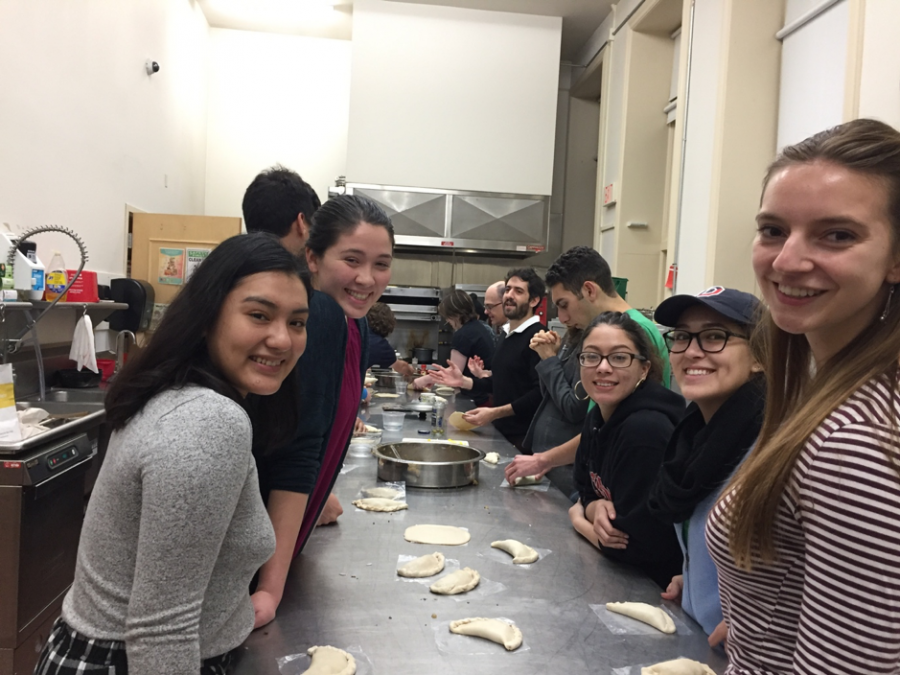Lafayette Professor Discusses Argentinian Gender Norms with Postcards and Empanadas
A professor from Lafayette College used empanadas and an iconic photograph from 1894 to start a conversation on gender norms in Argentina.
Photographer Francisco Ayerza took the photograph of a woman serving mate, a popular South American herbal tea, to a man departing on horseback. This image was modified and widely circulated in postcard form, according to the Dickinson College website.
“[The fact that] this kind of image has become iconic has something to do with the reality that women are often the ones serving the mate, and they are often expected to do it in a deferential fashion,” said Dr. Rebekah E. Pite from Lafayette College.
Ayerza intended the original photograph to be used in his photo series picturing gauchos, or South American countrymen, with their horses. Instead, the photo has become well-known and has inspired interpretations and reproductions.
The picture portrays the gaucho in a physically higher position than the indigenous woman serving the tea. The man’s face is also more visible. Pite said this positioning suggests the man has power over the woman.
Pite also discussed how national culture in Argentina and Uruguay relate to the place of the woman in heterosexual romance. This dynamic can be observed through other works of the late 19th and 20th century, said Pite, including in derivations of the “Stirrup Mate” photo, which is named for the man with his foot in the saddle’s stirrup.
Some less popular versions of this picture include two men serving mate for each other and a picture that includes captions describing the woman. One, roughly translated to English, reads “beauty is important for a woman; also grace and generosity.”
Shantel Hernandez ’21 said she found Pite’s focus on the value of female roles in historical Argentinian patriarchal society, where the male is usually the protagonist, interesting. “It’s great how modern artists are uprising the voices of indigenous people in Argentina,” said Hernandez.
Prior to the talk, Pite joined about 20 Dickinson professors and students to make empanadas, a baked pastry with beef filling.
Professor of History Marcelo Borges had read Pite’s book “Creating a Common Table in Twentieth-Century Argentina: Dona Petrona, Women, & Food,” and then suggested inviting Pite to campus. Carolina Castellanos, chair of the Latin American, Latino, and Caribbean studies (LALC), and Madeline Brown, LALC’s administrative assistant, organized the event.
“We hope that students learn something specific about one of the regions/countries that LALC covers and connect it with other LALC areas,” said Castellanos. “With the food workshop, we also hope to create a sense of community within Dickinson and develop engagement with LALC.” She said she enjoyed seeing students making empanadas together, laughing and asking Pite questions.
“My host mom has taught me how to make them [empanadas], and I now want to know where I can get the material to make them here in the U.S.,” said Mollie Montague ’19, who studied abroad in Argentina. “Once you come back from abroad, you don’t always feel like you have that opportunity to connect with some of the things you learn and things you love when you were abroad, so this has been really nice to do that again.”
“I attended the talk because it called [to] my attention that someone from the United States was interested in Argentina and especially in such a traditional thing like the mate is,” said Gaston Dorigutti, an exchange student from Argentina.
“I am passionate about studying Latin America and I believe culture, including food, is a central part of understanding the region,” said Gabriella Farrell ’21, who said she wanted to understand more about the cuisine before studying abroad in Argentina next year.
The event was co-sponsored by LALC Studies, Food Studies, the Spanish department and the Portuguese department. It took place on Nov. 8 in Stern.






